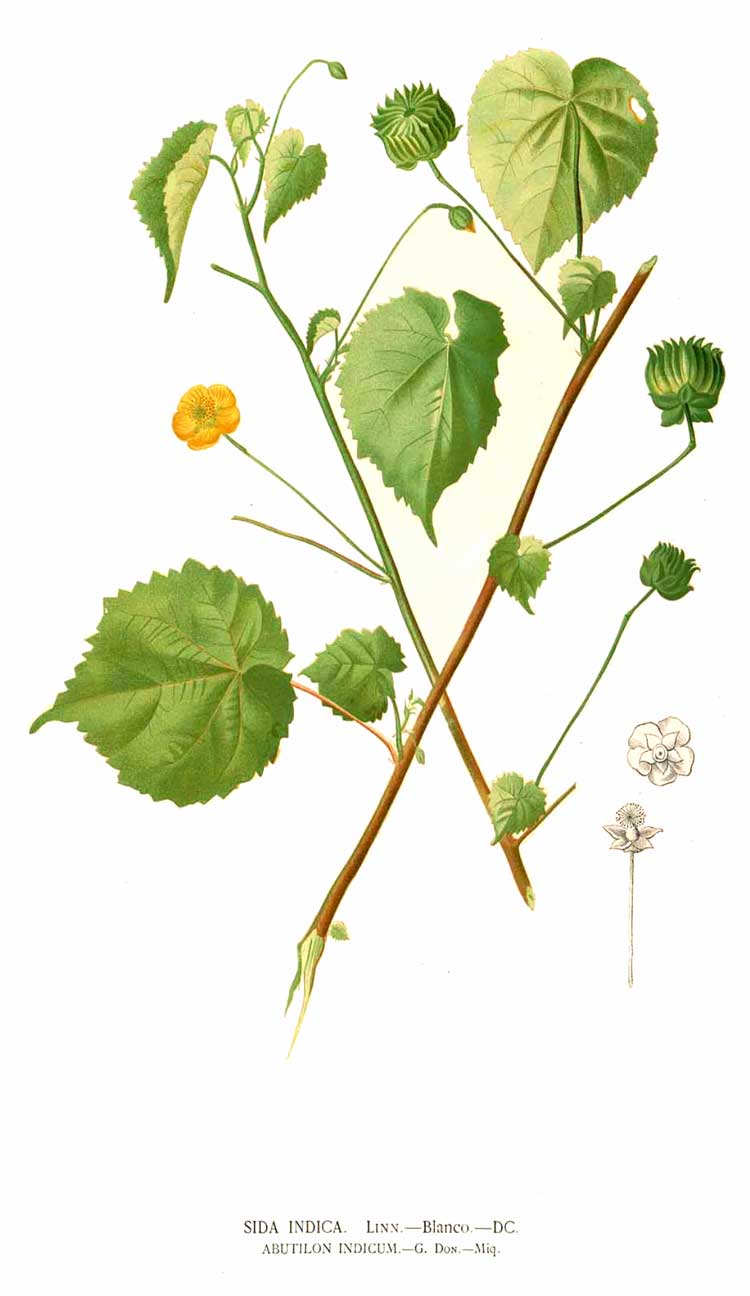
Abutilon indicum
Classification System: APG IV
Superregnum: Eukaryota
Regnum: Plantae
Cladus: Angiosperms
Cladus: Eudicots
Cladus: Core eudicots
Cladus: Rosids
Cladus: Eurosids II
Ordo: Malvales
Familia: Malvaceae
Subfamilia: Malvoideae
Tribus: Malveae
Genus: Abutilon
Sectio: A. sect. Abutilon
Series: Abutilon ser. Axilliflorae
Species: Abutilon indicum
Subspecies: A. i. subsp. albescens – A. i. subsp. indicum
Name
Abutilon indicum (L.) Sweet, Hort. Brit. 1: 54. (1826)
Synonyms
Basionym
Sida indica L., Cent. Pl. 2: 26. (1756)
References
Primary references
Sweet, R. 1826. Sweet’s Hortus Britannicus: or a catalogue of plants cultivated in the gardens of Great Britain, arranged in natural orders. 492 pp. in 2 parts, London: J. Ridgway. Part I (pp. 1–240) Part II (pp. 241–492) Reference page.
Links
Govaerts, R. et al. 2021. Abutilon indicum in Kew Science Plants of the World online. The Board of Trustees of the Royal Botanic Gardens, Kew. Published on the internet. Accessed: 2021 Jan. 17. Reference page.
Hassler, M. 2021. Abutilon indicum. World Plants: Synonymic Checklists of the Vascular Plants of the World In: Roskovh, Y., Abucay, L., Orrell, T., Nicolson, D., Bailly, N., Kirk, P., Bourgoin, T., DeWalt, R.E., Decock, W., De Wever, A., Nieukerken, E. van, Zarucchi, J. & Penev, L., eds. 2021. Species 2000 & ITIS Catalogue of Life. Published on the internet. Accessed: 2021 Jan. 17. Reference page.
International Plant Names Index. 2021. Abutilon indicum. Published online. Accessed: Jan. 17 2021.
Tropicos.org 2021. Abutilon indicum. Missouri Botanical Garden. Published on the internet. Accessed: 2021 Jan. 17.
USDA, ARS, Germplasm Resources Information Network. Abutilon indicum in the Germplasm Resources Information Network (GRIN), U.S. Department of Agriculture Agricultural Research Service. Accessed: 07-Oct-06.
Vernacular names
தமிழ்: துத்தி
Abutilon indicum (Indian abutilon, Indian mallow) is a small shrub in the family Malvaceae, native to tropical and subtropical regions. This plant is a valuable medicinal and ornamental plant, its roots and leaves being used for curing fevers. It has been widely introduced outside of its native range, and is considered invasive on certain tropical islands.[1]
Hindi name: कंंघाइ "Kanghai"
Urdu name: کنگھی "Kanghi"
Tamil name: துத்தி "thuthi"
Sanskrit name: अतिबला Atibalaa
Telugu name: Duvvena Kayalu "duvvena benda"(దువ్వెన బెండ)
Kannada name: TuThThi gida (ತುಥ್ಥಿ ಗಿಡ)
Malayalam name:വെള്ളൂരം
Odia name: ପେଡ଼ି ପେଡ଼ିକା "Pedi Pedika" [2]
Distribution
The species occurs in a number of tropical and subtropical zones. An example occurrence is within parts of the Great Barrier Reef islands of the Coral Sea.[3]
Traditional medicine
In traditional medicine, A. indicum various parts of the plant are used as a demulcent, aphrodisiac, laxative, diuretic, sedative, astringent, expectorant, tonic, anti-convulsant,[4] anti-inflammatory,[5] anthelmintic, and analgesic and to treat leprosy, ulcers, headaches, gonorrhea, and bladder infection.[6] The whole plant is uprooted, dried and is powdered. In ancient days, maidens were made to consume a spoonful of this powder with a spoonful of honey, once in a day, for 6 months until the day of marriage, for a safe and quick pregnancy.[7]
The plant is commonly used in Siddha medicines. The root, bark, flowers, leaves and seeds are all used for medicinal purposes by Tamils. The leaves are used as adjunct to medicines used for pile complaints. The flowers are used to increase semen in men.[8][unreliable medical source?]
Abutilon indicum.
Chemistry
β-Sitosterol is present in A. indicum and a petroleum ether extract has larvicidal properties against the mosquito larvae Culex quinquefasciatus.[9] A methanol extract of A. indicum has some antimicrobial properties.[10]
References
"Abutilon indicum". Pacific Island Ecosystems at Risk. Retrieved 2008-06-18.
"Archived copy". Archived from the original on 2016-12-18. Retrieved 2016-12-06.
C.Michael Hogan (2011). "Coral Sea". In P. Saundry; C.J. Cleveland (eds.). Encyclopedia of Earth. Washington DC: National Council for Science and the Environment.
Anticonvulsant activity of Abutilon indicum Leaf. Dharmesh K Golwala, Laxman D Patel, Santosh K Vaidya, Sunil B Bothara, Munesh Mani, Piyush Patel. International Journal of Pharmacy and Pharmaceutical Sciences (IJPPS) (ISSN 0975-1491), Sagar, India. 2010: Volume 2, Issue 1, page: 66-72.[1]
Anti-inflammatory activity of Abutilon indicum Linn. Leaf. DK Golwala, LD Patel,SB Bothara, SK Vaidya, AR Sahu, S Kumar. Research Journal of Pharmaceutical & Technology (ISSN Online: 0974-360X; Print: 0974-3618), Raipur, India. 2010: Volume 3, Issue 1, page: 433-439.[2]
Nishanta Rajakaruna; Cory S. Harris; G.H.N. Towers (2002). "Antimicrobial Activity of Plants Collected from Serpentine Outcrops in Sri Lanka" (PDF). Pharmaceutical Biology. 40 (3): 235–244. doi:10.1076/phbi.40.3.235.5825. S2CID 53004266.
Pandikumar, P.; Chellappandian, M.; Mutheeswaran, S.; Ignacimuthu, S. (2011). "Consensus of local knowledge on medicinal plants among traditional healers in Mayiladumparai block of Theni District, Tamil Nadu, India". Journal of Ethnopharmacology. 134 (2): 354–362. doi:10.1016/j.jep.2010.12.027. PMID 21193023.
J.Raamachandran, "Herbs of Siddha Medicines – The First 3D Book on Herbs, p. 4
A. Abdul Rahuman; Geetha Gopalakrishnan; P. Venkatesan; Kannappan Geetha (2008). "Isolation and identification of mosquito larvicidal compound from Abutilon indicum (Linn.) Sweet". Parasitology Research. 102 (5): 981–988. doi:10.1007/s00436-007-0864-5. PMID 18176816. S2CID 845151.
Jigna Parekh; Nehal Karathia; Sumitra Chanda (2006). "Screening of some traditionally used medicinal plants for potential antibacterial activity". Indian Journal of Pharmaceutical Sciences. 68 (6): 832. doi:10.4103/0250-474X.31031.
Retrieved from "http://en.wikipedia.org/"
All text is available under the terms of the GNU Free Documentation License

